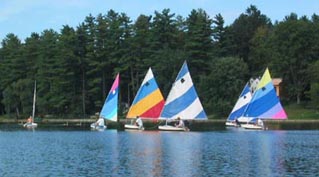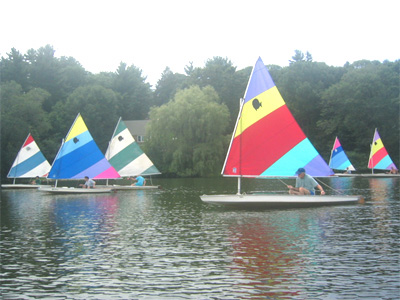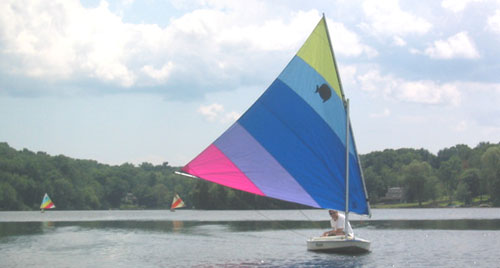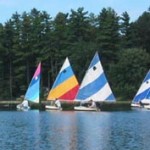 The Lewisboro Ledger | Thursday, September 02, 2004 Edition
The Lewisboro Ledger | Thursday, September 02, 2004 Edition
By J.B. COZENS
Vi Patek sounded an air horn across Lake Truesdale early Sunday afternoon, and over the next half hour, sailboats materialized and slowly congregated to the north end of the lake near the Patek house.
Only seven boats came for the weekly racing series of Sunfish Fleet No. 27, but that hardly mattered: They were upholding a Lake Truesdale ritual that stretches back more than a half century.
Through 50 years and several generations, Fleet No. 27 has managed to stay afloat. “It’s kept going, pretty much,” said John Blair, whose involvement in the races goes back to the fleet’s beginning, in the 1950s. “It’s been a tremendous activity, I think, for the community.”
One of the oldest Sunfish fleets in the country, the Lake Truesdale Sunfish sailors have been competing for the fleet championship trophy since 1960. Before that, races were held with the Sunfish’s wooden predecessor, the Sailfish.
 Mr. Blair said the Sailfish races were started in the early 50s and the Sunfish series was held every year from 1960 to 1979, and then weathered some gaps over the next two decades.
Mr. Blair said the Sailfish races were started in the early 50s and the Sunfish series was held every year from 1960 to 1979, and then weathered some gaps over the next two decades.
But after a two-year lapse from 1996 to 1997, the races resurfaced again in 1998 and have been held for the last six years.
“Over the years there’s been breaks where there was nobody organizing it, and there wouldn’t be any official races, and then it would start up again,” said longtime fleet member Jack Fles.
Sailors who must have lake rights to be fleet members take the competition seriously, but the objective of the racing series is to get people out onto the lake and forget about their lawnwork and housework for a while.
“By having something that’s regular, it forces you to have some fun,” said Mark Patek, who took over running the races in the early 1970s from Mr. Blair. “It gets people out there to socialize.”
“It is a lot of fun. It’s a tradition,” Mr. Fles said. “We want to keep it going. We just can’t seem to get people interested.”
While the race boasted as many as 30 boats during its heyday in the 50s and 60s, the numbers have dwindled over the following decades ‹ particularly the number of young people.
Fifteen racers competed this summer, with a best turnout of nine boats for one race. The lowest turnout was three.
“You never know how many will show up,” said Mr. Patek, whose house has served as the start and finish line for the past 18 years.
“It ebbs and flows. There are people who come out for one or two races,” said Robert Cummings, who has raced on Lake Truesdale for the last four years.
The summer series of 20 races officially begins at the end of June, and runs 10 Sundays through the Labor Day weekend, with two races held each Sunday. Buoys mark the course which, depending on the conditions, can be one long course or a short, two-lap course.
Races begin with a two-minute countdown, as sailors jockey for the best position and wind so when the final start horn is sounded they are a step ahead of the competition.
“There’s a lot of tactics,” Mr. Patek said. “The lake is difficult to sail because the wind comes over the mountain, drops and spreads out 360 degrees. You end up with all kinds of wind shifts. If you can race well on the lake, you can race anywhere.”
Fleet members earn one point each for starting and finishing a race, and one point for each boat they beat in a given race; race winners also receive an additional half point. 
Only a racer’s top 10 races count to the overall standings. At season’s end, the points winner is bestowed the honor of Fleet Champion and keeps the trophy for the next year.
Lately, the trophy’s home has been that of Mr. Fles, who at 82 years old is the two-time defending champion. He is also leading the overall standings heading into this weekend’s final races of the season.
On Sunday, however, it was Mr. Patek who was the winner in both races, pulling him to within four points of Mr. Fles in the overall standings.
The two men have a friendly rivalry that goes back many years. Mr. Fles won the first Sunfish Fleet No. 27 trophy in 1960, and has captured the trophy a total of five times, while Mr. Patek has taken the trophy home a record nine times. In the last six years, they’ve each won it three times.
With two races to go, Mr. Fles (77 points) and Mr. Patek (73 points) are vying for the trophy. Other top scorers are Ray Morse (59.5), Ira Sanchick (45), Robert Cummings (44.5), Skip Jahn (41) and Mike Dollar (25). Results are posted at: http://truesdalelake.com/sunfish.
The fleet encourages racers of all levels to compete; three of Sunday’s seven sailors were beginners, Mr. Patek said. Those new to sailing are traditionally given a two-minute head start. Most importantly, they learn how to sail; and over time, they get good at it.
“A lot of the people never sailed,” Mr. Patek said. “Ray Morse started as a complete beginner and was the champion one or two times.”
Another racer out on the lake on Sunday was Mr. Cummings, who didn’t pick up sailing until three years ago but managed to win one race this summer. He said the experienced sailors got him through the first year by offering advice and help.
“Mark Patek sat in my boat for a couple of races early on and showed me how to tack into the wind,” he said. “Everyone is very, very friendly.”
Mr. Cummings hopes to get his two sons involved in sailing in the coming years.
After this Sunday’s weekly races, the season ends on Labor Day with a special annual race called The President’s Cup. There is a separate trophy and the race is typically longer than the summer series races.
The fleet’s other main award is for Most Improved. For the past four years, the recipient of that award has received a painting of boats sailing on Lake Truesdale by artist Joan Fles.
The history of the Lake Truesdale fleet goes back to the 1920s, when a small stream was dammed to form the lake. Mr. Patek said that, according to old-timers, the current lake had been a marshy area known as Truesdale Swamp.
In the 1950s, residents around the lake organized into a fleet and began holding weekly races.
What got things going, according to both Mr. Blair and Mr. Fles, was a bet between two men over who could race their boat the fastest around the lake.
“The whole thing started with a match race,” recalled Mr. Blair. “Everyone seemed to enjoy it, and we organized and we registered the fleet.”
It started as a Sailfish fleet. That boat was wooden and had no well ‹ basically, a flat piece of wood.
“You’d lie on it like a surfboard,” said Mr. Fles, who at that time was racing on a sail canoe.
The Sunfish — the most popular sailboat in history — came along in the late 50s, and the fleet became a Sunfish fleet from that point.
“It’s the perfect boat for the size of the lake we have,” Mr. Blair said.
The early days of the fleet were its most successful. Since boats then required an extra hand on deck for races, and the lighter the crew the better, more children were brought on board.

“It introduced a lot of young people to sailing, and they liked it and they got their own boats and carried on. We built up to about 30 boats at one point. It got so crowded around the buoys we decided to divide the fleet up into two sections,” said Mr. Blair, who organized the race and was a race judge for many years. All three of his sons raced in the family’s Sunfish, and it was only after they were grown that Mr. Blair got his turn.
“When they graduated and the boat became free, I raced for quite a few years.”
The fleet also had a separate ladies’ division for a short time, and for many years there were separate races for youngsters.
“The adults would race on Sunday and the kids would race on Saturday,” recalled Mr. Fles, who also had three sons who raced.
“We had enough for an official Junior fleet,” said Mr. Patek, whose three daughters all learned to sail on Lake Truesdale.
But over time, the number of young sailors declined.
“When I first started racing in 1972, one of the top sailors was a teenager. I think he won fleet champion. That we haven’t seen since the 70s or early 80s,” Mr. Patek said. “They’re all so busy. We just can’t seem to get them out there.”
“The kids nowadays are more interested in computers and staying indoors and they’re missing out on a lot of fun,” Mr. Blair said.

